Category: Hunting Blog
Newborn Fawns: What To Do When You Find One
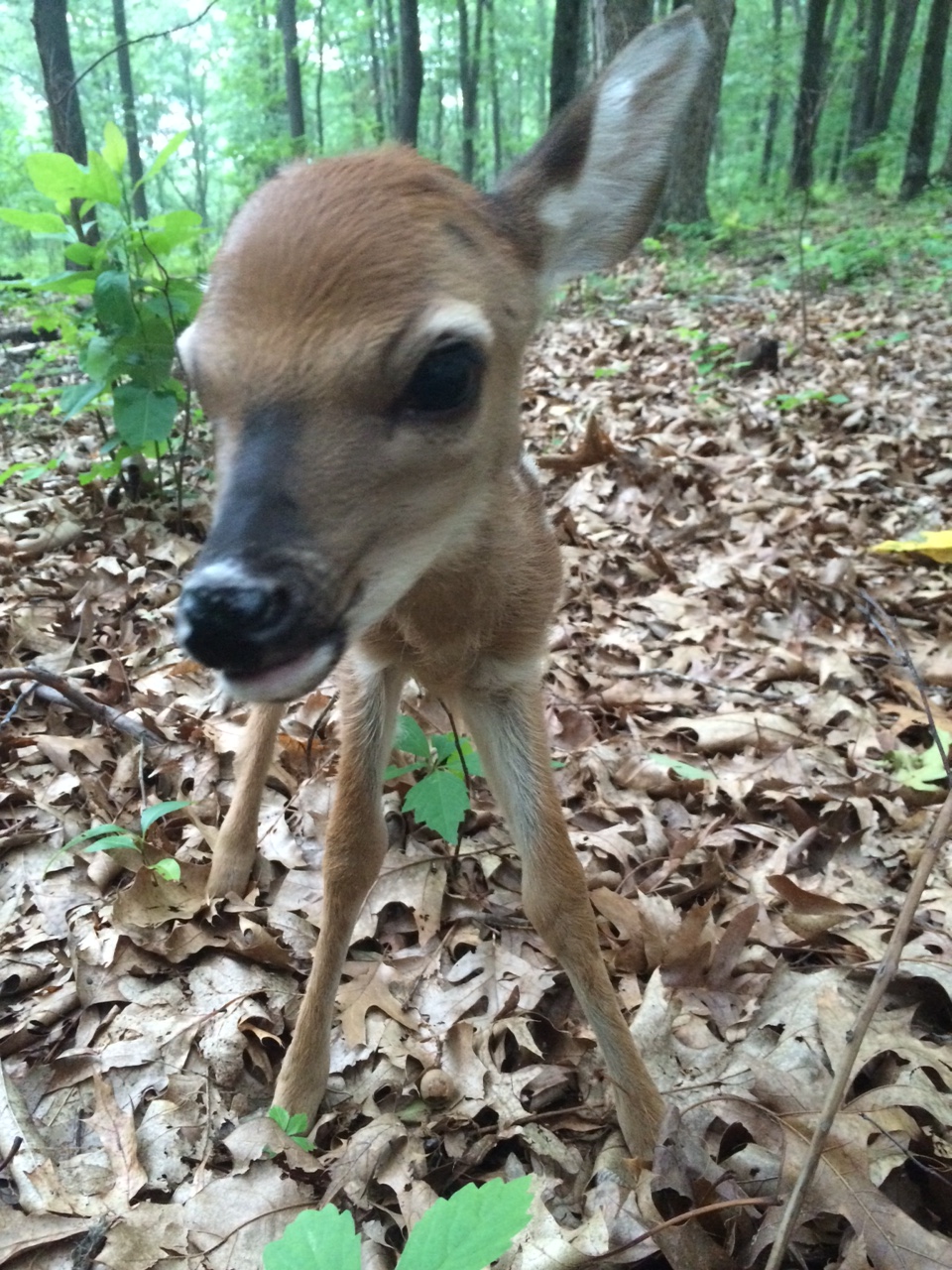
Intern Nick Halchin found this fawn recently. At this stage in life, fawns aren’t as aware of danger as mature deer and can fall to predators very easily.
Throughout most of the whitetail’s range fawns are being born. Predators, weather conditions, etc., can substantially reduce the odds of fawns surviving. In addition, well-meaning humans often also reduce fawns chances for survival.
New born fawns spend about the first ten days of their life in cover, hidden, and almost motionless. Research shows that they are bedded about 95% of the time during this period. Every spring I hear stories of people finding fawns and carrying them home because they didn’t see a doe. A fawn’s chance of survival almost always decreases significantly if removed from where it was placed by a doe.
Predation that occurs on fawns happens the most during these first few days of their life. Human disturbance to where a doe left a fawn adds scent, etc. and can actually attract predators to the fawn. That’s why it’s extremely important people don’t pick up and remove fawns from their hiding place. The doe is most likely close by and chances of survival rapidly decrease if the fawn is taken out of hiding.
Remember, fawns may seem extremely cute and adorable but they belong in the wild. Never pick up a fawn found in the wild. As conservationists it’s our duty to ensure a healthy life for the fawns, and the best way for us to do so is leaving them alone.
Daydreaming of whitetails,
Adam
Soybeans In Small Plots
Deer love soybeans! They are attracted to them from when they come out of the ground to the last pods available during late winter! Unfortunately, deer can damage and even kill soybeans if they browse them too much when they first start to grow.
Knowing this I often plant soybeans at twice the normal rate in small plots. This allows deer to feed but there are simply too many young soybean plants for all of them to be damaged.
Planting at a higher density doesn’t hurt the beans as the young plants are not competing for water and nutrients like more mature plants. By the time the soybeans mature deer have usually thinned the plant population enough that the remaining stems can mature without too much competition.
If you are planting small plots with soybeans, trying increasing the planting rate if deer are wiping out the crop before hunting season.
Growing Deer together,
Grant
Spring Nesting And Wet Weather
Now that turkey season has wrapped up here in Missouri, it’s time to get back to management projects! As we work to improve the habitat, the next generation of critters is being born and trying to survive and for some it can be very difficult.
We’ve had a very interesting spring so far. April came in dry, went out with a couple rainstorms, then May came in dumping rain. We’ve had a lot of rain, with even more rain coming this weekend. For turkey nests and poults this is troubling. There has been a lot of research studying the connection between hatch success rates with precipitation amounts. The higher amounts of rain we receive in May, the lower hatch rate and ultimately a lower population of turkeys.
The “wet hen theory” suggests that hen turkeys with wet feathers sitting on their nest release a higher amount of scent than a hen with dry feathers. Releasing more scent makes them more susceptible to predators, and even if they survive the predator encounter, there is a good chance the eggs won’t survive.
While planting my Eagle Seed soybeans, I’m happy to see the coming rainfalls, but as a turkey hunter I get a little uneasy knowing the potential harm for the turkeys.
Daydreaming of long beards and long spurs,
Adam
Antlers Are Back
Antlers are growing and the GrowingDeer Team is excited! As Missouri’s turkey season closes, checking our Reconyx cameras keeps a smile on our faces.
Many bucks have started growing antlers and it is thrilling to see who made it through the winter. It is another enjoyable season. Young bucks will be expressing their potential, making our mouths water, hoping they make it to maturity. New bucks (3.5 years old last year) will be added to the “hit list”. The mature bucks we have hunted year after year will again be fun to watch and pattern, but don’t expect the same antlers as last year.
Antlers can change year to year. It is always exciting to see what a new year will bring. Will a mature buck’s antlers begin to decline with age? Will a young buck’s antlers explode, expressing great potential? As you watch antlers develop this summer, enjoy the time getting to know each individual deer. You will begin to learn their habits, tendencies, and preferences. Each antler is unique, as is each deer.
One deer the GrowingDeer Team looks forward to watching is Two Face. Two Face is at least 10 years old and the relationship we have built over time is incredible. Each encounter, whether hunting (watch episode #269 here) or seeing a new picture, is a special moment.
So, grab your Reconyx cameras and a Trophy Rock! You will not want to miss the next few months. Antlers are growing bigger every day. Will you be watching?
Managing whitetails with you,
Daniel Mallette
Spring Turkey Hunting: A Recipe To Treat Your Mother
If you’ve been blessed with a successful turkey hunt and have a recently harvested turkey in your freezer, you now have a great meal for your mother this Sunday! Treat her to a home cooked meal of the best kind – natural, free-range wild turkey nuggets!
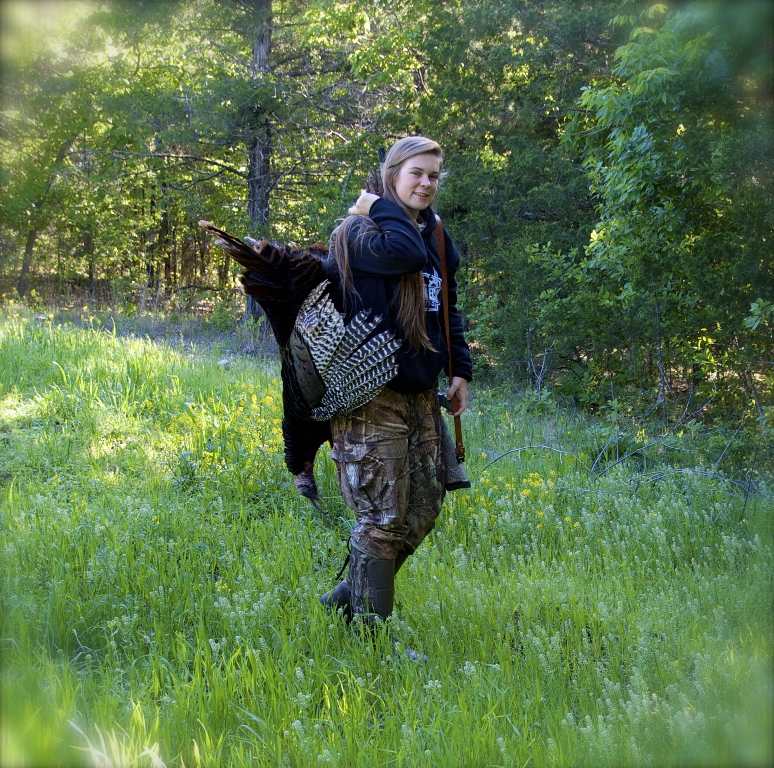
Raleigh provided a wild turkey for the freezer!
Salt
Pepper
Powdered garlic
Basil
Dash of paprika
Dash of cayenne pepper
4 cups all-purpose flour
1 cup cornmeal
Oil, for frying
Directions:
Fill a fryer or deep pot halfway with oil. Heat to 350 degrees F. Sprinkle the turkey nuggets liberally with salt, pepper, powdered garlic, and basil. Sprinkle the turkey nuggets with a dash of paprika and cayenne pepper. In a gallon size Ziploc© bag combine the flour and the cornmeal. Add the nuggets to the Ziploc© bag, close, then shake to cover the nuggets with the flour mixture. Remove the nuggets from the bag. Using a slotted spoon place the nuggets in the fryer. Deep fry for approximately 8 to 10 minutes until done. Drain on paper towels. Serve with baked potato or corn on the cob and a fresh green salad!
Variations:
- Marinate the turkey nuggets in your favorite BBQ sauce for a minimum of 30 minutes before breading (Grant likes a mustard base!).
- If you like a heavier breading, add 1 egg and ½ cup milk to the flour mixture (it should be roughly the consistency of pancake batter).
- Use this same batter recipe to cook fish, onion rings, mushrooms, etc. (And since you’ve tagged your turkey, what better reason to enjoy this beautiful spring weather than adding some fish to the menu!)
- If using it for cooking fish I recommend Old Bay or a cajun seasoning to replace the garlic and basil.
If you haven’t filled your tag yet (and the season is still open in your state) this recipe will give you a good reason (or excuse) to get out in the woods on Saturday. After all – it’s all for you, Mom!
Looking forward to my Mother’s Day meal,
Tracy
Turkey Nests And Predator Control
Turkey hunters, mushroom hunters, and other outdoor enthusiasts have been spending time in the outdoors during this time of year. There are so many beautiful pieces of God’s creation showing their full color right now, and no one should be missing it! One of my favorite things to see in the spring is turkeys, and even better, turkey nests! Finding one of these can be a real treat, and for those who pride themselves as “wildlife managers” we wonder, “How can we help these eggs?”
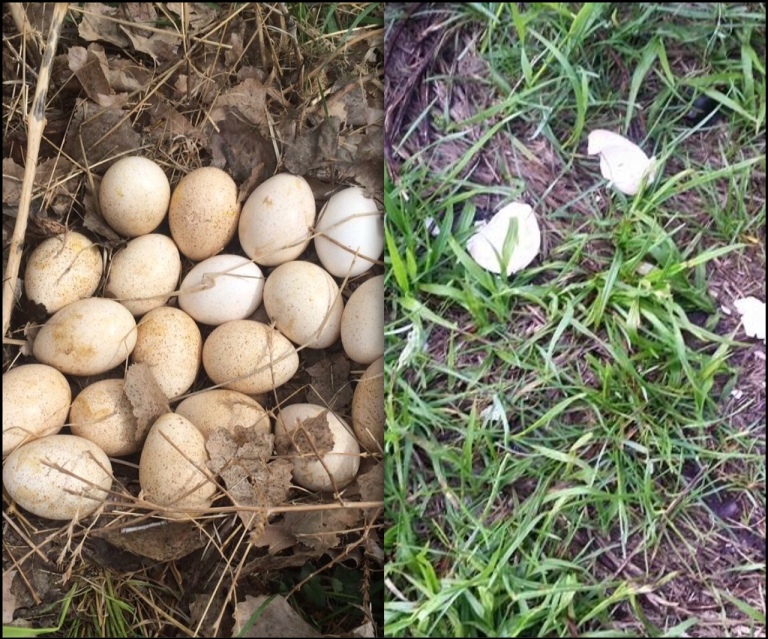
(Left) A healthy turkey nest with several eggs and no sign of predators. (Right) What happens when a nest predator finds the eggs.
As wildlife managers, it’s in our blood to try and improve the overall habitat quality and wildlife population. If you’re like me when you find something as frail as a turkey nest you want to step up your game to ensure these eggs will hatch and reach maturity. Obviously you can’t save all the turkey nests, but you can ensure that some of them will make it past birth.
First we need to understand that predators will harm the eggs, mother hen, and the newborn turkeys. Coyotes and bobcats prey on all of these, and definitely get the most attention as turkey predators, but don’t overlook the small predators like raccoons, opossums, and skunks. These small animals can definitely hurt the turkey population if their numbers are plentiful.
Lesson Learned – When trapping season is open in your area, put out your traps! Don’t stick with one set of traps and try to remove coyotes and bobcats either. Pick up some small traps to balance the predator prey relationship in your area! We use Duke Dog Proof or Duke Cage traps because they are simple and easy to use. Trapping turkey nest predators will save turkey lives, and who doesn’t want to enjoy a spring morning with turkeys gobbling?
Daydreaming of long beards and long spurs,
Adam
Missouri Turkey Season: The Tools Of The Trade
Proclaiming that I love this time of year is a complete understatement. Finding the words to express my happiness with springtime is very difficult. With the temperatures warming and the outdoors coming back to life, things are beautiful here at The Proving Grounds and things got even better this week with the opening of Missouri turkey season! Throughout the spring Grant and I are often asked what calls we use to lure those wary toms into range. Here is a list of exactly what we carry in our vest!
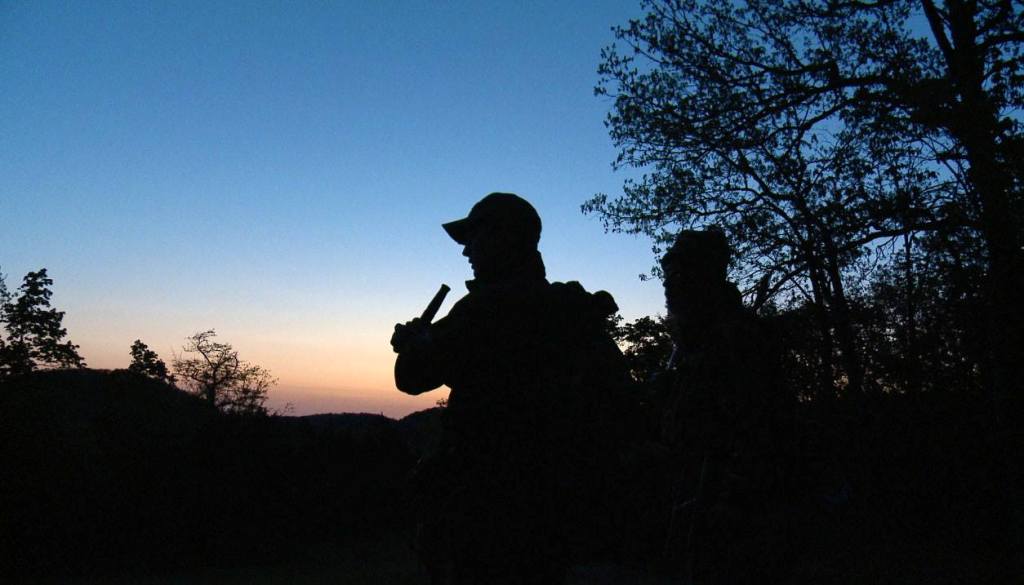
Adam using the Harrison Hoot’n Stick early in the morning trying to locate a gobbler.
Although we use a lot of similar calls there are a few minor differences. You can find all of these calls and more information about them at Hook’s Custom Calls.
Grant’s vest:
- Exterminator (crystal glass) – This is Grant’s go to friction call. Teamed up with the Yellowheart gobbler stick it creates great clear to mid rasp sounds.
- Assassin Slate – This call creates a wide range of tone but its specialty is those soft tree yelps early in the morning.
- Diaphragm Calls – Executioner, Swindler, and the Game Changer 3
My vest:
- Assassin Glass – This is my favorite call to try and tempt that gobbler into range. This glass call can create mid tone raspy yelps to high frequency rasps to locate those toms on the next ridge.
- Assassin Aluminum – Aluminum has been my favorite surface on a friction call for several years. It can hit the high ball rasp that I really love or mid range yelps as the tom approaches our setup.
- Diaphragm Calls – Enforcer, Shockwave, and the Game Changer 3
The locator calls we both use:
- Harrison Hoot’n Stick Walnut – This is almost always the first call we make early in the morning.
- Harrison Crow Call Walnut – As the sun comes up we’ll switch up our locator calls and use a crow call.
- Harrison Howler – Sometimes when birds want to be tight lipped a howl on this call can create a response.
We use these calls daily this time of year and we can’t wait to get back out there again to try our hand one more time!
Daydreaming of long spurs and long beards,
Adam
Scouting From The Skinning Shed
Several months every year hunters take to the woods to scout for their next hunt. We monitor trail cameras, observe creek crossings, and stare into soybean fields during the late summer for the chance to catch a glimpse of velvet antlers. We do a number of things, but when given the chance to obtain some of the most informative details we often let it slip through our fingers. This important information is something the GrowingDeer.tv Team never passes up and neither should you.
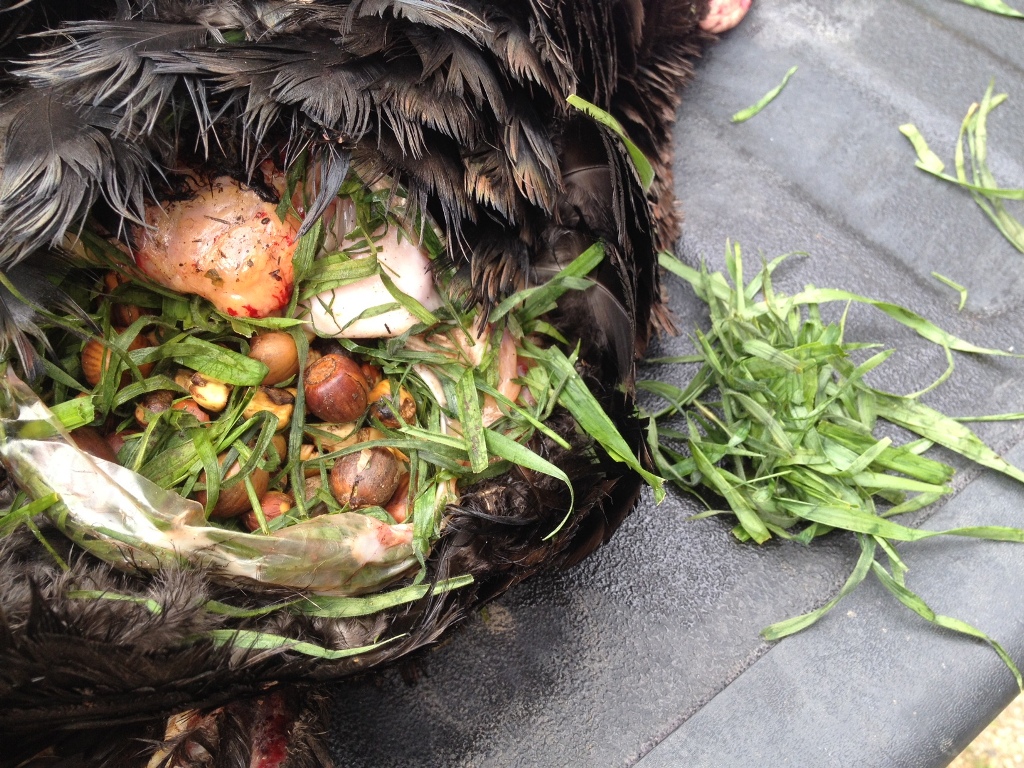
This turkey’s crop was filled with wheat and acorns of every size.
Every successful hunt is a learning experience. On top of all the excitement from the hunt, we can also gain information for our next hunt. Recently, Grant’s youngest daughter, Rae, harvested a nice bird during Missouri’s youth turkey season. The following day I took my Razor Blaze knife and cut into the crop of the turkey. The crop serves as the stomach of the turkey and by inspecting the interior of the crop you can learn where that turkey spent the day feeding. The crop of this specific turkey contained acorns and wheat. No surprise on the wheat, as this turkey was shot in an Eagle Seed Broadside plot which contains several different cool season plants. The acorns told us not to overrule hunting turkeys in the woods.
It’s mid April and a lot of hunters may believe that the acorn consumption is over and that animals will be using other food sources. After looking in the crop of this turkey, we know that’s not true. Season opens up for everyone in Missouri on Monday and you can bet at some point we’ll be chasing turkeys in the timber!
Daydreaming of long beards and long spurs,
Adam
Shed Hunting? My Advice – Don’t Start!
If you’ve never been shed antler hunting I have some advice for you. It’s simple – don’t go. Don’t go shed hunting. Don’t even start. Don’t even spend 15 minutes looking in a food plot for antlers. Why? Because once you do you will be addicted. I’ve seen it happen. The addiction only takes minutes to set in. I saw it happen just recently.
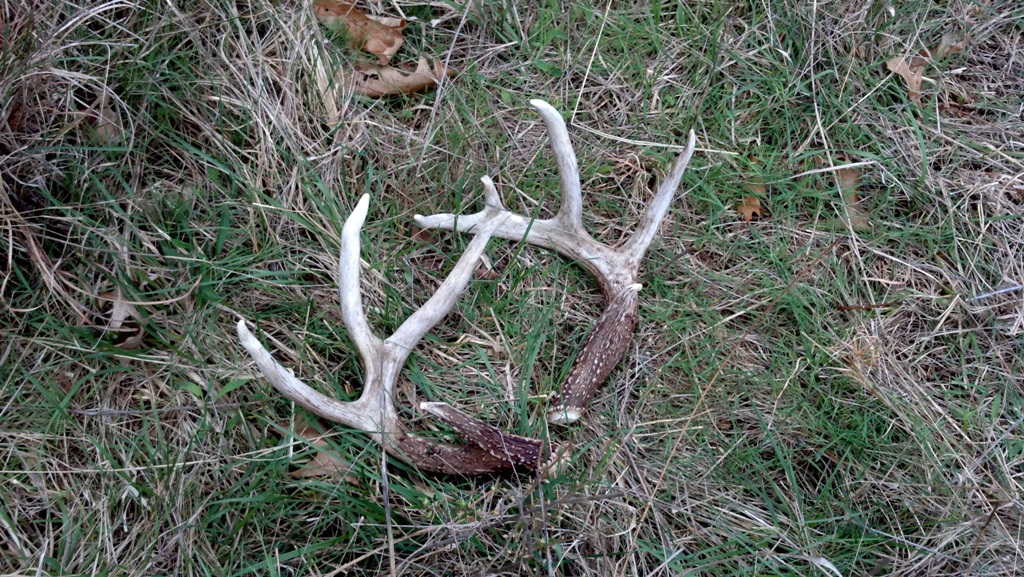
A matched set of shed antlers.
I had a family come join me on a recent Sunday afternoon to enjoy a couple of hours walking in the woods to hunt for shed antlers. Neither the husband nor wife had ever hunted for shed antlers. As a matter of fact, the husband prefers turkey hunting to deer hunting. However they love being outdoors, love hiking, and love letting their three boys run free in the woods where they can’t get in trouble when throwing a rock or busting up a tree stump.
Our hunt that afternoon focused on areas of high deer activity – the woods around frequently used food plots. As the hunt progressed I saw the hike turn from a casual family hike to an intense search for that elusive shed antler. I saw it on their faces – fierce concentration as they scanned the ground hoping to find one. It was like an early Easter egg hunt for adults.
They were full of questions. Where should I be looking? How do I find one? How many have you found in a day? What’s the most you’ve found in a season? Is it more of a thrill to find a big antler or a small antler?
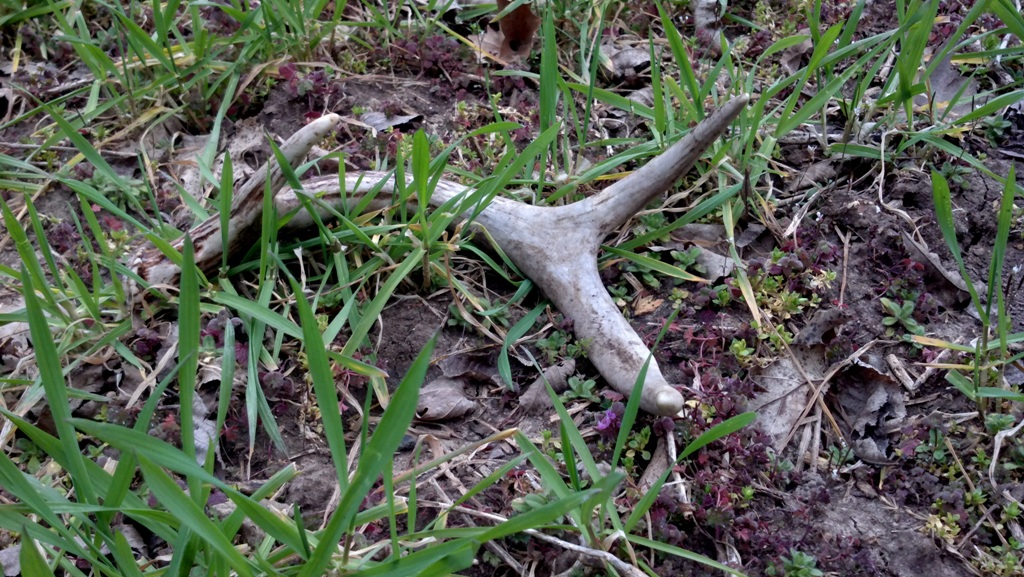
It’s very rewarding to find smaller shed antlers too!
As I answered each question I could see the desire to find an antler begin to burn stronger. My answers were simple: When you find deer trails, rubs, scrapes, deer beds, or deer poop slow down and check those areas out more thoroughly. I’ve found up to six antlers in one day. To me it’s more rewarding to find a small antler than a big one because you have to really be looking hard to find those! Of course, the big antlers are a bigger thrill to find and are what keeps everyone truly motivated.
The afternoon hunt ended with the boys playing in the creek, one shed antler found that was definitely shed more than a couple of years before, and at least two new addicts to hunting shed antlers.
The next time you consider taking up shed hunting – don’t do it. Don’t go. Just go for a walk in the spring woods. Take time to enjoy the warmer air, spring wildflowers, and budding trees. If you see an antler – leave it for the squirrels. You’ll be glad you did. (or not….)
Confessing my addition to shed antler hunting,
Tracy Woods
Tools Of The Trade: Filming A Turkey Hunt
Filming your hunt has become a very popular activity in the world of hunting. There are professionals, semi-professionals, and amateurs all just looking to capture the hunt to show friends and family. There are thousands of tools but sorting through them can be difficult. Below is a list of gear that I will be carrying in the following weeks to help bring you every new episode of GrowingDeer.tv!
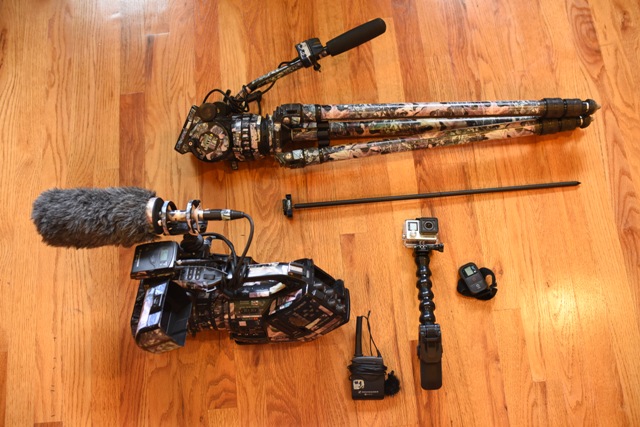
I film turkey hunts using a Sony EX3 with lavalier and shotgun mics, tripod, and GoPro with remote and ground stake.
- Primary camera – We use a Sony EX3 as our main camera. There are many great cameras to choose from. It’s important to have a primary camera with the appropriate attachments to help grab the essential pieces of every hunt. This camera can be the most expensive camera on the market or a small handy cam. The most important part is knowing your camera and capturing clear, focused footage.
- Tripod – Leaving this at home isn’t an option for us. Stable footage is a must and can only be captured by attaching the camera to a tripod. This means mobility is limited, but finding a balance between stable and mobile is dynamite.
- Shotgun and lavalier microphone – Having great audio is one of the main differences between amateurs and professionals. You can pick up either of these microphones for a couple hundred dollars online. Like cameras, the more expensive the better, by adding one of the two you will increase your quality significantly.
- Secondary camera(s) – POV cameras are becoming wildly popular, especially for hunters. GoPro cameras are attached to nearly everything on most hunting shows. Positioning one of these cameras back towards the hunter and cameraman during a hunt brings a real world look at the emotions and obstacles a hunter/cameraman go through. Having a secondary camera rolling through the hunt will also eliminate the need for recreates.
- Accessories – These tools aren’t essential but can increase your production value.
- POV ground stake – This stake is very basic but can capture killing footage! Mount a secondary camera to it and place it five yards from a decoy looking back towards the hunter.
- Slider – If you’re looking for that professional touch, grab a nice slider and incorporate it into your hunt. Sliders come in different sizes and shapes but the concept is the same. The track keeps the camera positioned almost exactly the same as the camera moves from one end of the slider to the other. This tool will add a nice movement to your shots.
- Suction cup mount – Attached to your secondary camera, this mount will be a great way to capture footage inside your vehicle going to and from your property.
- Remote control for primary camera – Attaching a thumb operated remote control to your tripod will mean the difference between comfort and aching muscles. By positioning your tripod arm closer to the ground and having the remote control attached it will allow you to operate your camera with your arms more relaxed and comfortable.
- Remote control for secondary camera – Having a remote control for your secondary camera will save battery life and eliminate the movement of trying to turn the camera on before a turkey comes in. The remote can be used to turn the camera on from several yards away without having to stand up and manually turn on the camera.
Most importantly, everything we carry in pursuit of turkeys is camouflage! Turkeys have incredible eyesight and all lights and shiny objects need to be covered with camouflage! Don’t overlook this tip! It could be the most important part of your hunt!
Daydreaming of long beards and long spurs,
Adam



